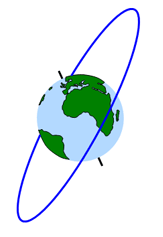Geosynchronous orbit: Difference between revisions
From Halopedia, the Halo wiki
mNo edit summary |
Halopediaman (talk | contribs) mNo edit summary |
||
| Line 1: | Line 1: | ||
{{Era|CH|H2|GOO}} | {{Era|CH|H2|GOO|RW}} | ||
{{references}} | {{references}} | ||
[[Image:Geosynchronous1.GIF|thumb|right|A diagram of a Geosynchronous orbit]] | [[Image:Geosynchronous1.GIF|thumb|right|A diagram of a Geosynchronous orbit]] | ||
A '''geosynchronous''' orbit is an orbit around a planet with an orbital period matching the planet's sidereal rotation period. A satellite having a geosynchronous orbit will orbit relative to the same, fixed position on its parent body (i.e. [[Earth]]) at the exact same time each day. The term geosynchronous can be used to describe any orbital pattern with a period equal to that of its orbiting body, and in the same direction as the parent's rotation, but is specifically used for orbits with no inclination and a semimajor axis of equal length to the minor axis (i.e. circular). This means that the orbiting body essentially appears to 'hover' or hold over a specific location during the entirety of its orbit. This also referred to as a geostationary orbit.<ref>http://en.wikipedia.org/wiki/Geosynchronous_Orbit</ref> | A '''geosynchronous''' orbit is an orbit around a planet with an orbital period matching the planet's sidereal rotation period. A satellite having a geosynchronous orbit will orbit relative to the same, fixed position on its parent body (i.e. [[Earth]]) at the exact same time each day. The term geosynchronous can be used to describe any orbital pattern with a period equal to that of its orbiting body, and in the same direction as the parent's rotation, but is specifically used for orbits with no inclination and a semimajor axis of equal length to the minor axis (i.e. circular). This means that the orbiting body essentially appears to 'hover' or hold over a specific location during the entirety of its orbit. This also referred to as a geostationary orbit.<ref>http://en.wikipedia.org/wiki/Geosynchronous_Orbit</ref> | ||
[[Orbital Defense Platform]]s in particular make use of geostationary orbits to protect certain ground regions from attack; [[Cairo Station]], for example, orbited directly over the city of Cairo, taking its name. The Athens Station also orbited above the [[Greece|Greek]] city of [[Athens (City)|Athens]]. Other satellites, predominately telecommunication satellites, orbit in traditional geosynchronous orbits, holding over the same point during every rotation of the [[Earth]]. The terminus stations of [[Space Elevator]]s are also anchored to the geosynchronous orbit. | [[Orbital Defense Platform]]s in particular make use of geostationary orbits to protect certain ground regions from attack; [[Cairo Station]], for example, orbited directly over the city of Cairo, taking its name. The Athens Station also orbited above the [[Greece|Greek]] city of [[Athens (City)|Athens]]. Other satellites, predominately telecommunication satellites, orbit in traditional geosynchronous orbits, holding over the same point during every rotation of the [[Earth]]. The terminus stations of [[Space Elevator]]s are also anchored to the geosynchronous orbit. | ||
Revision as of 16:40, March 6, 2010
| This article does not have enough inline citations and/or does not adhere to the proper citation format. You can help Halopedia by adding citations. |
A geosynchronous orbit is an orbit around a planet with an orbital period matching the planet's sidereal rotation period. A satellite having a geosynchronous orbit will orbit relative to the same, fixed position on its parent body (i.e. Earth) at the exact same time each day. The term geosynchronous can be used to describe any orbital pattern with a period equal to that of its orbiting body, and in the same direction as the parent's rotation, but is specifically used for orbits with no inclination and a semimajor axis of equal length to the minor axis (i.e. circular). This means that the orbiting body essentially appears to 'hover' or hold over a specific location during the entirety of its orbit. This also referred to as a geostationary orbit.[1]
Orbital Defense Platforms in particular make use of geostationary orbits to protect certain ground regions from attack; Cairo Station, for example, orbited directly over the city of Cairo, taking its name. The Athens Station also orbited above the Greek city of Athens. Other satellites, predominately telecommunication satellites, orbit in traditional geosynchronous orbits, holding over the same point during every rotation of the Earth. The terminus stations of Space Elevators are also anchored to the geosynchronous orbit.
